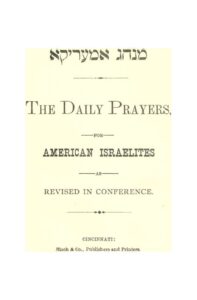This is an English edition of Rabbi Isaac Mayer Wise’s Tefilot Bnei Yeshurun: Minhag America daily prayerbook, first printed in 1857. (For the German edition, Gebetbuch für den Öffentlichen Gottesbienft und die Privat-Andacht, visit here.) This edition was entered into the Library of Congress in 1872.

This work is in the Public Domain due to its having been published more than 95 years ago.

“📖 תפלות בני ישורון (רפורמי) | The Daily Prayers for American Israelites, by Rabbi Isaac Mayer Wise (Minhag America, 1872)” is shared through the Open Siddur Project with a Creative Commons Public Domain Dedication 1.0 Universal license.










Leave a Reply